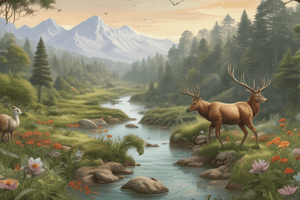Podcast
Questions and Answers
Define an ecosystem.
Define an ecosystem.
An ecosystem is a community of interacting organisms and their physical environment.
Explain the concept of biodiversity.
Explain the concept of biodiversity.
Biodiversity refers to the variety of life on Earth, including species, genetic diversity, and ecosystems.
What is conservation biology?
What is conservation biology?
Conservation biology is the study of the causes of biodiversity loss and the development of strategies to preserve it.
Describe ecological succession.
Describe ecological succession.
Explain population dynamics.
Explain population dynamics.
How does biodiversity contribute to human survival?
How does biodiversity contribute to human survival?
What is the difference between primary succession and secondary succession?
What is the difference between primary succession and secondary succession?
How do birth and death rates, migration, and predation influence population growth?
How do birth and death rates, migration, and predation influence population growth?
Explain the levels of ecological organization from population to biosphere.
Explain the levels of ecological organization from population to biosphere.
What are the different ways organisms obtain their nutrients?
What are the different ways organisms obtain their nutrients?
Describe mutualism in symbiosis and provide an example.
Describe mutualism in symbiosis and provide an example.
How do biomes differ from each other, and what factors contribute to their distinct characteristics?
How do biomes differ from each other, and what factors contribute to their distinct characteristics?
Flashcards are hidden until you start studying
Study Notes
Ecology: Understanding Ecosystems, Biodiversity, and Conservation
Ecology is the scientific study of the relationships between organisms and their physical environment, focusing on the interactions among organisms and the ecosystems in which they live. It encompasses various subtopics, including ecosystems, biodiversity, conservation biology, ecological succession, population dynamics, hierarchy of ecological organization, ecological level of organization, symbiosis, nutritional relationships, biomes, and more. In this article, we will explore these topics in detail, providing a comprehensive understanding of ecology.
Ecosystems
An ecosystem is a community of interacting organisms and their physical environment. Ecosystems can vary in size, from a single tidal wetland to the Amazon Rainforest. They are complex networks of relationships, where organisms depend on each other and their environment for survival. Ecosystems are characterized by the flow of energy and matter, and the cycling of nutrients.
Biodiversity
Biodiversity refers to the variety of life on Earth. It includes the variety of species, genetic diversity within species, and the variety of ecosystems. Biodiversity is crucial for maintaining ecological balance and provides essential resources for human survival.
Conservation Biology
Conservation biology is the study of the causes of biodiversity loss and the development of strategies to preserve it. It includes the study of endangered species, habitat conservation, and the management of natural resources.
Ecological Succession
Ecological succession is the process by which an ecosystem changes over time. It can be divided into two types: primary succession, where a new ecosystem forms on a previously uninhabited area, and secondary succession, where an existing ecosystem is disturbed and then recovers.
Population Dynamics
Population dynamics is the study of how the size and distribution of populations of species change over time. It includes the factors that influence population growth, such as birth and death rates, migration, and predation, as well as the interactions between populations and their environment.
Hierarchy of Ecological Organization
The hierarchy of ecological organization describes the different levels of organization in ecological systems. It includes the population level, community level, ecosystem level, and broader levels such as biomes and biosphere.
Ecological Level of Organization
The ecological level of organization refers to the different levels of complexity within ecological systems. It includes the individual organism level, population level, community level, and ecosystem level.
Symbiosis
Symbiosis is the close and long-term interaction between two or more different species. It can be mutually beneficial, where both species benefit, or parasitic, where one species benefits at the expense of the other.
Nutritional Relationships
Nutritional relationships describe the ways in which organisms obtain their nutrients. They include predation, herbivory, and parasitism.
Biomes
Biomes are large regions of Earth characterized by similar climates and vegetation. They include deserts, forests, grasslands, and tundra.
In conclusion, ecology is a multifaceted field that studies the interactions between organisms and their environment. By understanding the subtopics of ecology, we can gain a deeper appreciation for the complexity of nature and the importance of preserving biodiversity.
Studying That Suits You
Use AI to generate personalized quizzes and flashcards to suit your learning preferences.




